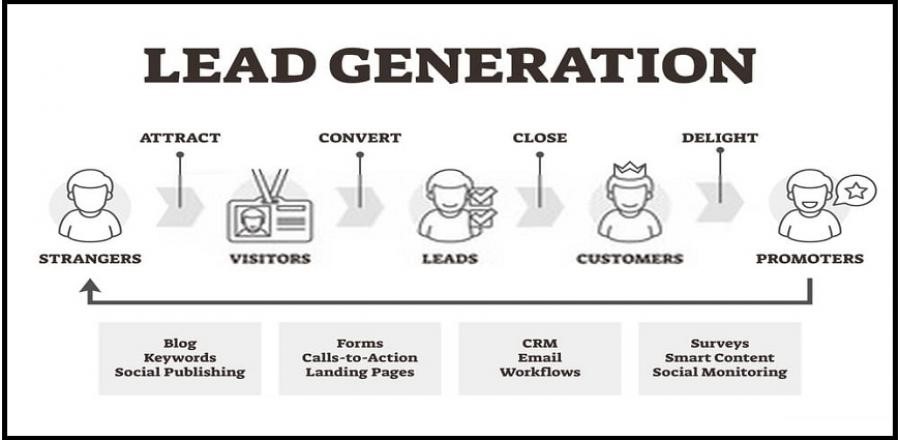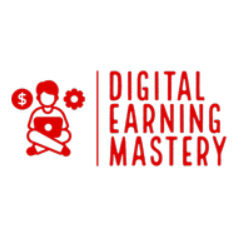This Lead Generation Step-by-Step Guide will help you from understanding your target audience to converting prospects into loyal customers.
Regardless of your experience level with lead generation, this guide offers useful advice and practical strategies to help you efficiently attract, nurture and convert prospects.

What is Lead Generation
The strategic method of drawing in and turning prospective clients into leads that is people who have shown interest in your goods or services is known as lead generation.
Objective: This procedure entails gathering contact details, including phone numbers or email addresses, so that companies can communicate with these potential customers.
Lead Generation Step-by-Step Guide
How it is done: A variety of focused marketing techniques are used to draw in new clients and convince them to provide their contact details in order to generate leads.
Lead Generation Strategy
Creating a successful lead generation strategy requires a deep understanding of the following:
- Define Your Target Audience
Demographics: Start by gathering key demographic details about your ideal customers, including age, gender, location, and income. This information helps you identify your potential leads and determine the best ways to reach them.
Psychographics: Explore the interests, values, and lifestyles of your target audience. Understanding their motivations and preferences allows you to craft messaging that resonates on a personal level.
Behavior: Examine the purchasing behaviors and product preferences of your audience. Knowing how they make buying decisions enables you to position your products or services as the ideal solution to their needs. - Set Clear Goals
Lead Quantity: Establish a specific target for the number of leads you want to generate within a given timeframe. Setting a numerical goal helps you track progress and assess the effectiveness of your lead generation efforts.
Lead Quality: Identify the traits that make a lead valuable to your business. Consider aspects such as budget, authority in decision-making, and purchasing readiness. High-quality leads are more likely to convert, so it’s important to prioritize quality. - Choose Lead Generation Channels
Organic: Use channels like SEO, content marketing, and social media to naturally attract leads. These methods focus on delivering valuable content and nurturing relationships with potential customers over time.
Paid: Implement PPC ads and social media advertising to quickly reach a targeted audience. Paid channels can drive immediate traffic to your landing pages, accelerating lead generation.
Referral: Leverage partner programs and client referrals to generate leads through word-of-mouth. Referral leads often come with higher trust levels and are more likely to convert, making them an essential component of your strategy.
Lead Generation Tactics
Lead generation tactics refer to the particular approaches and measures that companies employ in order to draw in and turn prospects into leads. Each can be modified to meet the demands of your company and the demographic you want to reach, assisting you in developing a strong lead generation plan that produces reliable, high-quality leads. Here are some successful strategies:
- Content Marketing:
Develop and share valuable content such as blog posts, ebooks, webinars, and videos that cater to the needs and interests of your target audience. Ensure this content includes calls-to-action (CTAs) that prompt readers to provide their contact information in exchange for more comprehensive resources. - Social Media Marketing:
Leverage social media platforms to distribute content, interact with your audience, and launch targeted ads. Social media enables you to expand your reach and direct traffic to your lead capture pages. - Influencer Marketing:
Collaborate with industry influencers to promote your products or services. Influencers can help you reach new audiences and generate leads by using their established credibility and influence. - Search Engine Optimization (SEO):
Enhance your website and content for search engines to boost visibility and attract organic traffic. By focusing on relevant keywords and making your site user-friendly, you improve the likelihood of potential leads discovering your business through search results. - Landing Pages and Lead Magnets:
Create specialized landing pages that are designed to capture lead information through forms. Offer lead magnets such as free trials, discounts, or exclusive content in exchange for contact details. - Email Marketing:
Cultivate and grow your email list by delivering personalized and pertinent content to your subscribers. Utilize email campaigns to guide leads through the sales funnel, providing value and fostering trust until they are ready to make a purchase. - Pay-Per-Click (PPC) Advertising:
Execute targeted PPC campaigns on platforms like Google Ads and social media to swiftly reach potential leads. PPC ads enable you to target specific keywords and demographics, driving visitors to your landing pages where they can be converted into leads. - Retargeting Ads:
Implement retargeting ads to reconnect with visitors who have previously engaged with your site but have not yet converted. By reminding them of your offerings, you increase the likelihood of turning them into leads. - Referral Programs:
Motivate current customers to refer new leads by offering incentives like discounts or rewards. Referral leads tend to have higher conversion rates due to the trust already established through the recommendation. - Webinars and Live Events:
Conduct webinars or live events to engage with your audience directly. These events provide an opportunity to showcase your expertise, answer questions in real time, and collect leads from participants.
Lead Generation Tools
You may increase conversions, enhance lead quality and accelerate lead generation process by combining these tools into your lead generating strategy.
- CRM Systems: Implement Customer Relationship Management (CRM) tools to efficiently manage and track leads. Solutions like HubSpot and Salesforce assist in organizing contact details, tracking lead interactions, and optimizing the sales process for better efficiency.
- Email Marketing Tools: Use platforms like Mailchimp and ConvertKit to automate and monitor your email campaigns. These tools enable you to craft targeted email sequences, track open rates, and fine-tune your messages to effectively nurture and convert leads.
- Analytics Tools: Employ analytics tools such as Google Analytics to evaluate the success of your lead generation efforts. These platforms offer valuable insights into website traffic, conversion metrics, and user behavior, allowing you to optimize your strategy.
- Social Media Management: Use social media management tools like Hootsuite and Buffer to oversee your social media activities. These tools help you schedule content, interact with your audience, and analyze the impact of your social media campaigns on lead generation.
- SEO Tools: Enhance your organic search rankings with SEO tools like Ahrefs and SEMrush. These platforms provide keyword research, backlink analysis, and site audits to attract more traffic and generate leads through search engines.
- Landing Page Builders: Quickly create optimized landing pages using platforms like Unbounce and Leadpages. These tools provide customizable templates and A/B testing capabilities to enhance conversion rates and capture leads more effectively.
- Live Chat Tools: Engage with website visitors in real-time through live chat tools such as Intercom and Drift. These tools enable instant communication, lead capture during conversations, and guide potential customers through the sales funnel.
- Chatbots: Automate lead capture and initial interactions with chatbot tools like ManyChat and Chatfuel. Chatbots can handle common queries, guide users through the sales process, and gather contact details even when you’re offline.
- Customer Feedback Tools: Collect valuable insights from leads and customers through feedback tools like SurveyMonkey and Typeform. These platforms allow you to create surveys and forms, helping you understand your audience better and refine your lead generation strategy.
- Lead Scoring Tools: Prioritize leads efficiently by utilizing lead scoring tools like Infer and Marketo. These platforms assign scores based on lead behavior, engagement, and fit, helping your sales team concentrate on the most promising prospects.
- PPC Management Tools: Optimize and manage your paid advertising efforts with tools like Google Ads and WordStream Advisor. These platforms help you track ad performance, adjust bidding strategies, and maximize your ROI in lead generation.
- Social Proof Tools: Build credibility and trust by leveraging social proof tools like FOMO and TrustPulse. These tools display real-time notifications of recent customer actions, such as purchases or sign-ups, encouraging new visitors to take similar actions.
- Referral Program Software: Streamline and manage referral programs using software like ReferralCandy and Ambassador. These tools help you incentivize existing customers to refer new leads, track referral activities, and reward participants effectively.
- Webinar Platforms: Manage and host webinars using platforms like Zoom and WebinarJam. Webinars serve as a powerful way to educate your audience, demonstrate expertise, and collect leads through registration forms.
Measuring and Optimizing Lead Generation
It is essential to regularly measure and improve your techniques if you want to make sure that your lead generation efforts are successful. You can improve the effectiveness of your campaigns and raise both the quality and number of leads by monitoring important metrics and making adjustments to your strategy in response to data.
- Key Metrics to Monitor:
Lead Conversion Rate: This metric indicates the percentage of site visitors who become leads. A higher rate suggests that your lead capture strategies are effective.
Cost Per Lead (CPL): Assess the expense involved in acquiring each lead to gauge the efficiency of your investment across various channels.
Lead Quality: Assess the leads based on factors like budget, authority, needs, and timeline (BANT). Higher-quality leads have a greater likelihood of turning into paying customers.
Lead Source Performance: Determine which channels (such as organic search, social media, or paid advertising) are generating the most leads, so you can invest more in the most successful sources.
Time to Conversion: Measure the duration it takes for a lead to advance through the sales funnel and become a customer. Shorter times typically reflect a more effective lead nurturing process. - Optimization Techniques:
A/B Testing: Regularly test various components of your lead generation strategy, including landing pages, CTAs, and email subject lines, to find out which ones perform best.
Audience Segmentation: Break down your audience into different segments based on demographics, behavior, or engagement. This allows you to tailor your messages and offers to each segment, boosting conversion rates.
Refining Lead Scoring: Periodically review and adjust your lead scoring criteria to ensure your sales team prioritizes the most promising leads.
Enhancing Content Relevance: Ensure the content provided at each stage of the buyer’s journey matches the needs and interests of your audience, which can boost engagement and conversion rates.
Improving User Experience (UX): Optimize your website and landing pages to enhance user experience, making it simpler for visitors to access information and complete lead capture forms. - Regular Review and Adjustment:
Regularly evaluate your lead generation performance. Use insights from key metrics to make adjustments to your strategies and tactics, ensuring ongoing improvement and alignment with your business objectives.
Best Lead Generation Practices
You can maximize your lead generation efforts, draw in high-quality leads and eventually increase the number of successful conversions by adhering to these best practices.
Personalization: Customize your communications and offers to align with the specific needs and preferences of each lead. Tailoring your approach helps build stronger connections and increases the likelihood of conversion.
Consistency: Ensure a uniform and regular presence across all selected channels. Consistent messaging and branding help reinforce your credibility and keep your business top-of-mind for leads.
Follow-Up: Establish a structured follow-up system to effectively nurture leads through the sales process. Consistent and timely follow-ups help maintain engagement and move leads closer to making a purchase decision.
- In any business, generating leads effectively is essential to its growth and success. You may create a solid source of prospective clients or consumers by knowing your target market, establishing clear goals and utilizing a range of channels and techniques.
- To stay ahead of the competition and accomplish your business goals, never forget to measure and optimize your efforts on a regular basis.
- Whether you’re utilizing email campaigns, social media, paid advertising, or content marketing, the most important thing is to be consistent, adjust to shifting trends, and keep your leads’ wants and interests first at all times.
- With the right approach and tools, you’ll be well on your way to generating high-quality leads and achieving sustainable growth.
